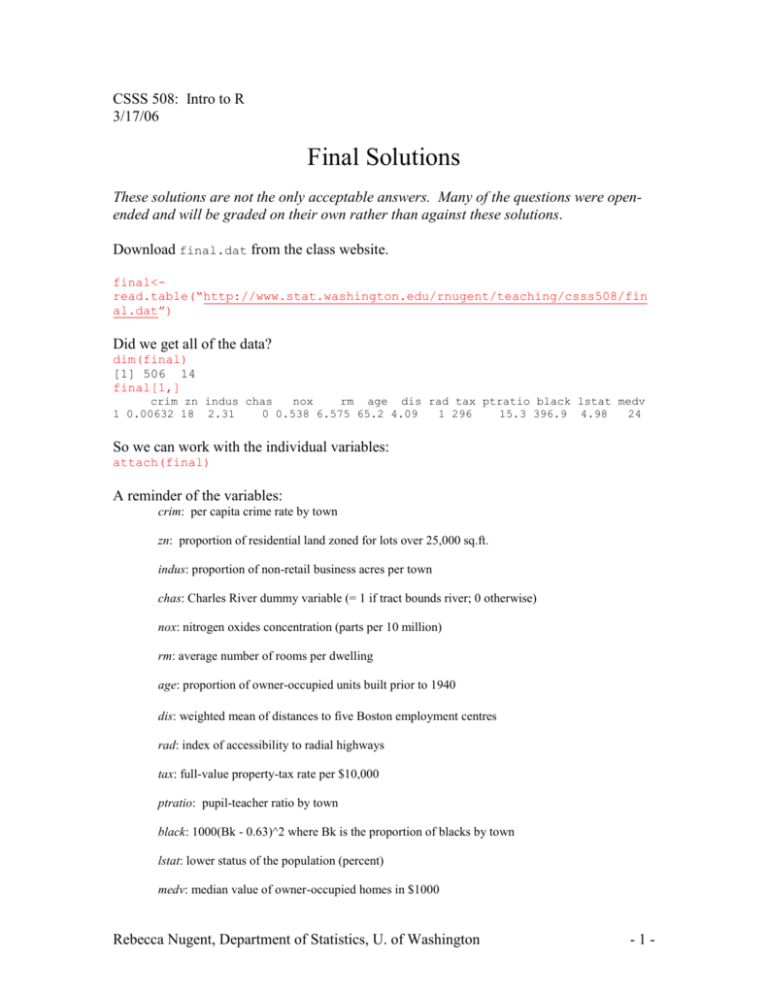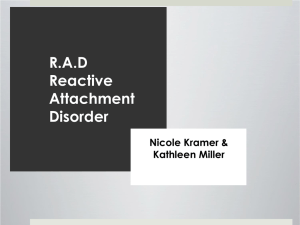Final Solutions - Department of Statistics
advertisement

CSSS 508: Intro to R
3/17/06
Final Solutions
These solutions are not the only acceptable answers. Many of the questions were openended and will be graded on their own rather than against these solutions.
Download final.dat from the class website.
final<read.table(“http://www.stat.washington.edu/rnugent/teaching/csss508/fin
al.dat”)
Did we get all of the data?
dim(final)
[1] 506 14
final[1,]
crim zn indus chas
nox
rm age dis rad tax ptratio black lstat medv
1 0.00632 18 2.31
0 0.538 6.575 65.2 4.09
1 296
15.3 396.9 4.98
24
So we can work with the individual variables:
attach(final)
A reminder of the variables:
crim: per capita crime rate by town
zn: proportion of residential land zoned for lots over 25,000 sq.ft.
indus: proportion of non-retail business acres per town
chas: Charles River dummy variable (= 1 if tract bounds river; 0 otherwise)
nox: nitrogen oxides concentration (parts per 10 million)
rm: average number of rooms per dwelling
age: proportion of owner-occupied units built prior to 1940
dis: weighted mean of distances to five Boston employment centres
rad: index of accessibility to radial highways
tax: full-value property-tax rate per $10,000
ptratio: pupil-teacher ratio by town
black: 1000(Bk - 0.63)^2 where Bk is the proportion of blacks by town
lstat: lower status of the population (percent)
medv: median value of owner-occupied homes in $1000
Rebecca Nugent, Department of Statistics, U. of Washington
-1-
Before we answer the questions, let’s look at what we have:
summary(final)
crim
Min.
: 0.00632
1st Qu.: 0.08190
Median : 0.25651
Mean
: 3.66439
3rd Qu.: 3.69599
Max.
:88.97620
NA's
: 8.00000
nox
Min.
:0.3850
1st Qu.:0.4490
Median :0.5380
Mean
:0.5544
3rd Qu.:0.6240
Max.
:0.8710
NA's
:2.0000
rad
Min.
: 1.000
1st Qu.: 4.000
Median : 5.000
Mean
: 9.583
3rd Qu.:24.000
Max.
:24.000
NA's
: 7.000
lstat
Min.
: 1.730
1st Qu.: 6.928
Median :11.465
Mean
:12.708
3rd Qu.:17.093
Max.
:37.970
NA's
: 6.000
zn
indus
chas
Min.
: 0.00
Min.
: 0.46
Min.
:0.00000
1st Qu.: 0.00
1st Qu.: 5.19
1st Qu.:0.00000
Median : 0.00
Median : 9.69
Median :0.00000
Mean
: 11.38
Mean
:11.21
Mean
:0.06986
3rd Qu.: 12.50
3rd Qu.:18.10
3rd Qu.:0.00000
Max.
:100.00
Max.
:27.74
Max.
:1.00000
NA's
: 10.00
NA's
: 8.00
NA's
:5.00000
rm
age
dis
Min.
:3.561
Min.
: 6.00
Min.
: 1.130
1st Qu.:5.883
1st Qu.: 45.10
1st Qu.: 2.100
Median :6.209
Median : 77.70
Median : 3.216
Mean
:6.284
Mean
: 68.73
Mean
: 3.797
3rd Qu.:6.626
3rd Qu.: 94.10
3rd Qu.: 5.212
Max.
:8.780
Max.
:100.00
Max.
:12.127
NA's
:6.000
NA's
: 5.00
NA's
: 5.000
tax
ptratio
black
Min.
:187.0
Min.
:12.60
Min.
: 0.32
1st Qu.:279.0
1st Qu.:17.40
1st Qu.:375.33
Median :330.0
Median :19.10
Median :391.34
Mean
:409.4
Mean
:18.47
Mean
:356.63
3rd Qu.:666.0
3rd Qu.:20.20
3rd Qu.:396.21
Max.
:711.0
Max.
:22.00
Max.
:396.90
NA's
: 5.0
NA's
: 3.00
NA's
: 9.00
medv
Min.
: 5.00
1st Qu.:16.80
Median :21.20
Mean
:22.52
3rd Qu.:25.00
Max.
:50.00
NA's
: 8.00
Note that the chas was treated as numeric even though it’s really categorical (Yes/No).
table(chas)
chas
0
1
466 35
We have missing data in all the variables. In our analysis, we have a couple of choices:
A) We could remove all suburbs that have one or missing values.
> sub.miss<-NULL
> for(i in 1:506)
+
if(any(is.na(final[i,]))) sub.miss<-c(sub.miss,i)
> sub.miss
[1]
2
4
9 11 15 19 23 27 31 33 37 41 42 45 60 73 78 87 101
[20] 104 109 115 116 138 150 151 152 170 175 176 186 191 199 202 206 207 219 224
[39] 228 235 238 242 251 256 262 270 272 275 276 278 285 289 294 298 299 309 312
[58] 313 314 317 318 321 327 335 345 351 353 359 376 382 383 413 423 435 436 450
[77] 454 456 464 497 506
This choice would remove 81 rows (suburbs) from our data matrix.
B) We could just remove missing values while doing the analyses (na.rm = T, etc.).
Some of these suburbs are only missing one value and removing them from the analysis
completely (as in choice #1) can delete useful information. We’ll be using option #2 for
the first few questions. When modeling in questions 5 and 6, the R procedures will
remove all observations/suburbs that have one or more missing values (option #1). But
we’re going to try to maximize using the information we have while we can.
Rebecca Nugent, Department of Statistics, U. of Washington
-2-
1) The majority of the zn values are zero. That is, many suburbs have no residential land
zoned for lots over 25,000 sq ft. Compare the mean and variance of indus and rad for
those suburbs who have no residential land zoned and those who have at least some
residential land zoned.
table(zn)
zn
0 12.5 17.5
364
10
1
55
60
70
2
4
3
18
1
75
3
20
21
21
4
80 82.5
15
2
22
10
85
2
25
10
90
5
28
3
95
4
30
6
100
1
33
4
34
3
35
3
40
7
45 52.5
6
2
We need to create a categorical variable indicating whether or not the suburb has no
residential land zoned.
zn.zero<-ifelse(zn==0,1,0)
table(zn.zero)
zn.zero
0
1
132 364
Looking at the relationship between zn and indus (proportion of non-retail business acres)
boxplot(indus[zn.zero==1],indus[zn.zero==0],names=c(“Zero Res. Land
Zoned”, “Some Res. Land Zoned”),main=”Proportion of Non-Retail Business
Acres”)
0
5
10
15
20
25
Proportion of Non-Retail Business Acres
Zero Res. Land Zoned
Some Res. Land Zoned
mean(indus[zn.zero==1],na.rm=T)
13.64589
var(indus[zn.zero==1],na.rm=T)
39.9314
mean(indus[zn.zero==0],na.rm=T)
4.471641
var(indus[zn.zero==0],na.rm=T)
6.187686
Rebecca Nugent, Department of Statistics, U. of Washington
-3-
The suburbs with no residential land zoned for lots over 25,000 sq ft have a much higher
proportion of non-retail business acres. Large lots usually correspond to business parks,
strip shopping centers, shopping malls, etc. It would make sense that areas with no zoned
lots of this size would have a higher proportion of non-retail businesses. The variance of
this group is also much higher, likely due to outliers.
To test if the difference in means is significant, we could use a t-test.
t.test(indus[zn.zero==1],indus[zn.zero==0])
Welch Two Sample t-test
data: indus[zn.zero == 1] and indus[zn.zero == 0]
t = 22.9887, df = 481.554, p-value = < 2.2e-16
alternative hypothesis: true difference in means is not equal to 0
95 percent confidence interval:
8.390102 9.958394
sample estimates:
mean of x mean of y
13.645889 4.471641
We do have a significant difference between the mean of the two groups.
Now looking at the relationship between zn and rad (index of accessibility to radial
highways – highways which lead out of the city)
boxplot(rad[zn.zero==1],rad[zn.zero==0],names=c(“Zero Res. Land Zoned”,
“Some Res. Land Zoned”),main=”Index of Accessibility to Radial
Highways”)
5
10
15
20
Index of Accessibility to Radial Highways
Zero Res. Land Zoned
Some Res. Land Zoned
mean(rad[zn.zero==1],na.rm=T)
11.51811
var(rad[zn.zero==1],na.rm=T)
90.14981
mean(rad[zn.zero==0],na.rm=T)
4.484615
var(rad[zn.zero==0],na.rm=T)
3.398986
Rebecca Nugent, Department of Statistics, U. of Washington
-4-
Suburbs with no residential land zoned for large lots have a higher average accessibility
to radial highways. However, the variance is extremely large (because of the 130 24’s).
table(rad[zn.zero==1])
1
6
2
18
3
24
4
72
5
75
6
17
8 24
17 130
We can test if this difference in means is significant:
t.test(rad[zn.zero==1],rad[zn.zero==0])
Welch Two Sample t-test
data: rad[zn.zero == 1] and rad[zn.zero == 0]
t = 13.3576, df = 423.684, p-value = < 2.2e-16
alternative hypothesis: true difference in means is not equal to 0
95 percent confidence interval:
5.998506 8.068475
sample estimates:
mean of x mean of y
11.518106 4.484615
Yes, we do have a significant difference in the means of the two groups.
2) The rm variable is real-valued (because it is an average). Create a categorical
variable rm2 that rounds the number of rooms to the nearest integer. What are the
different values of number of rooms now and how often do each of them occur?
First, a reminder of what rm looks like:
summary(rm)
Min. 1st Qu.
3.561
5.883
Median
6.209
Mean 3rd Qu.
6.284
6.626
Max.
8.780
NA's
6.000
rm2<-round(rm,0)
summary(rm2)
Min. 1st Qu. Median
4.000
6.000
6.000
Mean 3rd Qu.
6.268
7.000
Max.
9.000
NA's
6.000
Different values of number of rooms:
sort(unique(rm2))
[1] 4 5 6 7 8 9
How often do each of them occur?
table(rm2)
rm2
4
5
6
7
5 37 307 124
8
24
9
3
The most frequent values are 6-room and 7-room houses.
Rebecca Nugent, Department of Statistics, U. of Washington
-5-
3) Use graphs to illustrate the differences (for at least three variables) between towns
with a pupil-teacher ratio of less than 20 and towns with a pupil-teacher ratio of greater
than or equal to 20. The choice of graph should be appropriate for the variable. Graphs
should also be clearly labeled. Describe what you see.
First we need to create a categorical variable indicating whether or not the suburb’s pupilteacher ratio is greater than or equal to 20.
summary(ptratio)
Min. 1st Qu. Median
12.60
17.40
19.10
Mean 3rd Qu.
18.47
20.20
Max.
22.00
NA's
3.00
pt.20<-ifelse(ptratio>=20,1,0)
table(pt.20)
pt.20
0
1
302 201
Graphically looking at differences (a few at a time):
m<-matrix(c(1,2,3,4,5,6),ncol=2)
layout(m)
#Crime Rate: very different distributions; best looked at with histograms
hist(crim[pt.20==1],xlab=”Per Capita Crime Rate”,main=”Crime: PT Ratio >= 20”)
hist(crim[pt.20==0],xlab=”Per Capita Crime Rate”,main=”Crime: PT Ratio < 20”)
# Proportion of Residential Land zoned:
#the huge frequency of zn = 0 makes the distribution hard to graph. Probably more useful to look at the
#table of the two indicator variables (zn = 0 yes/no vs. pt.ratio >= 20 yes/no)
barplot(table(zn.zero,pt.20),beside=T, names=c(“Pt.Ratio >=20”,
“Pt.Ratio<20”),legend.text=c(“None Zoned”, “Some Zoned”),main=”Residential
Zoning vs. PT Ratio”)
#Proportion of Non-retail business acres per town: very different distributions; best looked at with histograms
hist(indus[pt.20==1],xlab="Proportion of Non-Retail Business
Acres",main="Indus: Pt Ratio >=20")
hist(indus[pt.20==0],xlab="Proportion of Non-Retail Business
Acres",main="Indus: Pt Ratio < 20")
#Charles River: dummy variable; again we look at the table of the two indicator variables
barplot(table(chas,pt.20),beside=T, names=c(“Pt.Ratio >=20”,
“Pt.Ratio<20”),legend.text=c(“Bounds River”, “Doesn’t Bound
River”),main=”Charles River vs. PT Ratio”)
Rebecca Nugent, Department of Statistics, U. of Washington
-6-
0 20
60
Frequency
80
0
Frequency
40
100
Indus: Pt Ratio >=20
120
Crime: PT Ratio >= 20
20
40
60
80
0
5
10
15
20
25
Per Capita Crime Rate
Proportion of Non-Retail Business Acres
Crime: PT Ratio < 20
Indus: Pt Ratio < 20
30
40
Frequency
0
20
150
0
50
Frequency
60
0
1
2
3
4
0
5
10
15
20
Proportion of Non-Retail Business Acres
Residential Zoning vs. PT Ratio
Charles River vs. PT Ratio
25
250
Per Capita Crime Rate
100 150
0
Bounds River
Doesn't Bound River
0
0
50
50
150
None Zoned
Some Zoned
Pt.Ratio >=20
Pt.Ratio<20
Pt.Ratio >=20
Pt.Ratio<20
The per capita crime rate appears to be much higher in towns with a greater pupil-teacher ratio. The
proportion of non-retail business acres is not distributed that much differently when you look at the actual
frequencies excepting a very large peak around 15-20% in the suburbs with a large pupil-teacher ratio.
Differences in amount of residential land zoned are apparent in suburbs with a low pupil-teacher ratio. The
differences between suburbs on the river and off the river do not appear to depend greatly on the pupilteacher ratio.
Rebecca Nugent, Department of Statistics, U. of Washington
-7-
par(mfrow=c(3,2))
#Nitrogen Oxides Concentration (parts per 10 million)
boxplot(nox[pt.20==1],nox[pt.20==0],names=c(“Pt.Ratio >=20”,
“Pt.Ratio<20”),main=”NOX vs. PT Ratio”)
#Average number of rooms per dwelling
boxplot(rm[pt.20==1],rm[pt.20==0],names=c(“Pt.Ratio >=20”,
“Pt.Ratio<20”),main=”Avg # of Rooms vs. PT Ratio”)
#Proportion of owner-occupied units built prior to 1940
boxplot(age[pt.20==1],age[pt.20==0],names=c(“Pt.Ratio >=20”,
“Pt.Ratio<20”),main=”# of Units built pre-1940 vs. PT Ratio”)
#weighted mean of distances to five Boston employment centers
boxplot(dis[pt.20==1],dis[pt.20==0],names=c(“Pt.Ratio >=20”,
“Pt.Ratio<20”),main=”Dist to Employment Centers vs. PT Ratio”)
# Index of Accessibility to radial highways: very different distributions but integer-valued
#better to use barplots but we want the ranges to be the same
rad1.freq<-rad2.freq<-rep(0,max(rad,na.rm=T)-min(rad,na.rm=T)+1)
for(i in 1:506){
if(!is.na(pt.20[i])){
if(pt.20[i]==1) rad1.freq[rad[i]]<-rad1.freq[rad[i]]+1
if(pt.20[i]==0) rad2.freq[rad[i]]<-rad2.freq[rad[i]]+1
}
}
barplot(rad1.freq,xlab=”Index of Accessibility to Radial
Highways”,names=seq(1,24),col=3,main=”Rad: PT Ratio >=20”)
barplot(rad2.freq,xlab=”Index of Accessibility to Radial
Highways”,names=seq(1,24),col=3,main=”Rad: PT Ratio < 20”)
Avg # of Rooms vs. PT Ratio
4
5
6
7
8
0.4 0.5 0.6 0.7 0.8
NOX vs. PT Ratio
Pt.Ratio >=20
Pt.Ratio<20
Pt.Ratio >=20
Dist to Employment Centers vs. PT Ratio
2
20
4
40
6
60
8
10 12
80 100
# of Units built pre-1940 vs. PT Ratio
Pt.Ratio<20
Pt.Ratio >=20
Pt.Ratio<20
Pt.Ratio >=20
Rad: PT Ratio < 20
0
0 20
20
40
60
60
100
80
Rad: PT Ratio >=20
Pt.Ratio<20
1
3
5
7
9
11 13 15 17 19 21 23
Index of Accessibility to Radial Highw ays
1
3
5
7
9
11 13 15 17 19 21 23
Index of Accessibility to Radial Highw ays
In suburbs with a higher pupil-teacher ratio, the nitrogen oxides concentration appears to be higher. The
average number of rooms doesn’t seem to be dependent on the pupil-teacher ratio; suburbs with a low
pupil-teacher ratio perhaps have slightly larger houses. Suburbs with high pupil-teacher ratios have older
houses (but note the large number of outliers) and are closet to employment centers. With regards to
accessibility to radial highways, there appears to be a group of high pupil-teacher ratio suburbs with better
access. Otherwise, the shape of the distributions is not that different (taking into account the frequencies).
Rebecca Nugent, Department of Statistics, U. of Washington
-8-
m<-matrix(c(1,2,5,3,4,6),ncol=2)
layout(m)
# full-value property-tax rate per $10,000: very different distributions but integer-valued
#better to use barplots but we want the ranges to be the same
start.pos<-min(tax,na.rm=T)
end.pos<-max(tax,na.rm=T)
tax1.freq<-tax2.freq<-rep(0,end.pos-start.pos+1)
for(i in 1:506){
if(!is.na(pt.20[i])){
if(pt.20[i]==1) tax1.freq[tax[i]-(start.pos-1)]<-tax1.freq[tax[i]-(start.pos-1)]+1
if(pt.20[i]==0) tax2.freq[tax[i]-(start.pos-1)]<-tax2.freq[tax[i]-(start.pos-1)]+1
}
}
barplot(tax1.freq,xlab=”Property Tax”,names=seq(start.pos,end.pos),col=3,main=”Tax: PT
Ratio >=20”)
barplot(tax2.freq,xlab=”Property Tax”,names=seq(start.pos,end.pos),col=3,main=”Tax: PT
Ratio < 20”)
# 1000(bk-0.63)^2 : bk – proportion of blacks by town
#very different distributions best looked at with histograms
#NOTE: very small and very large values of bk both give large values of black
hist(black[pt.20==1],xlab="(Transformed) Proportion of Blacks by Town",main="Blacks: Pt
Ratio >=20")
hist(black[pt.20==0],xlab="(Transformed) Proportion of Blacks by Town ",main="Blacks: Pt
Ratio < 20")
# lower status of the population (percent)
boxplot(lstat[pt.20==1],lstat[pt.20==0],names=c(“Pt.Ratio >=20”,
“Pt.Ratio<20”),main=”Lower Status vs. PT Ratio”)
# median value of owner-occupied homes in $1000
boxplot(medv[pt.20==1],medv[pt.20==0],names=c(“Pt.Ratio >=20”,
“Pt.Ratio<20”),main=”Median House Value vs. PT Ratio”)
Blacks: Pt Ratio >=20
80
40
0
0
40
80
Frequency
120
120
Tax: PT Ratio >=20
187 244 301 358 415 472 529 586 643 700
0
100
200
300
400
(Transformed) Proportion of Blacks by Tow n
Tax: PT Ratio < 20
Blacks: Pt Ratio < 20
150
0
0
50
5 10
Frequency
20
250
30
Property Tax
187 244 301 358 415 472 529 586 643 700
50
100
150
200
250
300
350
(Transformed) Proportion of Blacks by Tow n
Lower Status vs. PT Ratio
Median House Value vs. PT Ratio
400
5
10
20
15
30
25
40
35
50
Property Tax
Pt.Ratio >=20
Pt.Ratio<20
Pt.Ratio >=20
Pt.Ratio<20
Aside from the large group of outlier suburbs in the high pupil-teacher ratio group, the property taxes don’t
seem that dependent on pupil-teacher ratio (note frequencies).
The distributions of the transformed suburbs’ percentages of blacks do not seem dependent on pupilteacher ratio. However, this variable could be misleading as both small and large percentages of blacks
will lead to similar values of the variable. Suburbs with a higher pupil-teacher ratio have a higher
percentage of lower status citizens and a lower median house value.
Rebecca Nugent, Department of Statistics, U. of Washington
-9-
4) Write a function plot.by.quartile that takes as arguments:
1) a continuous variable to be categorized by quartiles (var1)
2) a matrix of continuous variables (should not include var1)
Within the function, we want to do the following:
First, categorize var1 by quartiles, i.e. create an indicator variable with a 1, 2, 3, or 4 for each observation
identifying its quartile. Then for each of the continuous variables in the matrix from the second argument
(the columns), create two plots. The first is a scatterplot of var1 vs. the continuous variable with suburbs
in different quartiles of var1 labeled with different colors and symbols. Use a legend to identify the
symbols you used.
The second plot will be four boxplots of the distributions of the continuous variable for each quartile of
var1, i.e. splitting the values by the categorized var1. Remember that your boxplots should all be on the
same graph space so values can be easily compared across plots. Plots should be labeled/titled
appropriately.
(So if we pass in crim and a matrix with columns zn and dis, we will have two scatterplots: one of crim vs.
zn and one of crim vs. dis. Each observation in the scatterplots is labeled according to its crim quartile.
Then we will have four boxplots of the zn values. The first boxplot shows the zn distribution for the suburbs
in the first crim quartile and so on. Similarly, we have four boxplots of the dis values, again with the
suburbs split by the crim quartiles.)
Also, find the mean for all four var1 quartile groups of suburbs for each continuous variable. Return the
means in a matrix with 4 rows and as many columns as continuous variables in the matrix.
(If we pass in crim and a matrix with columns zn and dis, we return a mean.matrix of size 4 by 2.
The first row is the mean zn value and mean dis value for the first crim quartile group of suburbs; the
second row is the mean zn value and the mean dis value for the second crim quartile group of suburbs and
so on.)
We have four main tasks in the function:
1) find the quartiles of the first argument variable
2) create scatterplots
3) create boxplots
4) find means
We want the function to be as general as possible – the function starts with several lines
of code finding the dimensions of the passed-in arguments as well as the names of the
variables. In order to get variable names for plot labels, we pass in var1 as a one-column
matrix with the corresponding column name. We have missing values in our data, so we
need to double check for NA when categorizing as well as when finding the means.
Rebecca Nugent, Department of Statistics, U. of Washington
- 10 -
plot.by.quartile<-function(var1,cont.var.matrix){
##Finding dimensions, names, creating space, etc.
var.name<-colnames(var1)
n<-nrow(var1)
var1<-as.numeric(var1)
col.labels<-colnames(cont.var.matrix)
n.col<-ncol(cont.var.matrix)
mean.matrix<-matrix(NA,4,n.col)
##Categorizing Var1
sum.var1<-summary(var1)
var1.quart<-rep(NA,n)
for(i in 1:n){
#need to check if missing first
if(!is.na(var1[i])){
if(var1[i]<=sum.var1[2]) var1.quart[i]<-1
else if(sum.var1[2]<var1[i] & var1[i]<=sum.var1[3]) var1.quart[i]<-2
else if(sum.var1[3]<var1[i] & var1[i]<=sum.var1[5]) var1.quart[i]<-3
else var1.quart[i]<-4
}
}
par(mfrow=c(2,2))
for(i in 1:n.col){
current.var<-cont.var.matrix[,i]
##The Scatterplots
plot(var1,cont.var.matrix[,i],xlab=var.name,ylab=col.labels[i],type="n")
points(var1[var1.quart==1],current.var[var1.quart==1],col=2,pch=12)
points(var1[var1.quart==2],current.var[var1.quart==2],col=3,pch=13)
points(var1[var1.quart==3],current.var[var1.quart==3],col=4,pch=16)
points(var1[var1.quart==4],current.var[var1.quart==4],col=5,pch=18)
legend(locator(1),legend=c(“Q1”,”Q2”,”Q3”,”Q4”),col=c(2,3,4,5),pch=c(12,13,16,18),cex=.7)
title(paste(var.name,” by “,col.labels[i]))
##The Boxplots
boxplot(current.var[var1.quart==1],current.var[var1.quart==2],current.var[var1.quart==3],current.
var[var1.quart==4],names=c(“Q1”,”Q2”,”Q3”,”Q4”),xlab=var.name,ylab=col.labels[i])
title(main=paste(var.name,” by “,col.labels[i]))
##The Means
mean.matrix[1,i]<-mean(current.var[var1.quart==1],na.rm=T)
mean.matrix[2,i]<-mean(current.var[var1.quart==2],na.rm=T)
mean.matrix[3,i]<-mean(current.var[var1.quart==3],na.rm=T)
mean.matrix[4,i]<-mean(current.var[var1.quart==4],na.rm=T)
}
rownames(mean.matrix)<c(paste(var.name,”Q1”),paste(var.name,”Q2”),paste(var.name,”Q3”),paste(var.name,”Q4”))
colnames(mean.matrix)<-col.labels
return(mean.matrix)
}
Rebecca Nugent, Department of Statistics, U. of Washington
- 11 -
a)
crim2<-matrix(crim,ncol=1)
colnames(crim2)<-“crim”
plot.by.quartile(crim2,cbind(zn,dis))
The Means:
crim
crim
crim
crim
zn
dis
Q1 33.954545 5.610604
Q2 9.126016 4.549608
Q3 2.533333 2.993749
Q4 0.000000 1.991203
100
crim by zn
100
crim by zn
80
60
zn
40
20
0
0
20
40
zn
60
80
Q1
Q2
Q3
Q4
40
60
80
Q1
Q3
crim
crim by dis
crim by dis
Q4
10
8
dis
2
2
4
6
6
8
10
Q1
Q2
Q3
Q4
4
dis
Q2
crim
12
20
12
0
0
20
40
crim
60
80
Q1
Q2
Q3
Q4
crim
Recall that the zn variable is largely zeros. It looks, however, that the suburbs with zero
residential land zoned for large lots have the highest per capita crime rate. These suburbs
are likely urban areas where there is less room for large lots for malls, shopping centers,
etc. The suburbs with the highest per capita crime rate are the closest to the five chosen
employment centers.
Rebecca Nugent, Department of Statistics, U. of Washington
- 12 -
medv2<-matrix(medv,ncol=1)
colnames(medv2)<-“medv”
plot.by.quartile(medv2,cbind(crim,zn,nox,dis,ptratio))
The Means:
medv
medv
medv
medv
crim
zn
nox
Q1 11.1452963 0.4065041 0.6661760
Q2 1.7302255 6.7016129 0.5494177
Q3 0.9899643 12.9173554 0.5120240
Q4 0.8120767 25.2375000 0.4931549
dis
2.288350
3.976149
4.508082
4.324222
60
crim
0
20
40
0
20
30
40
50
Q1
Q2
medv by zn
medv by zn
80
60
0
20
40
zn
60
zn
40
20
0
20
30
40
50
Q1
Q2
medv
0.8
0.7
nox
0.4
0.5
0.6
0.4
0.5
0.6
0.7
0.8
Q4
medv by nox
Q1
Q2
Q3
Q4
20
30
40
50
Q1
Q2
Q3
medv
medv by dis
medv by dis
Q4
12
medv
12
10
dis
2
4
6
2
4
6
8
10
Q1
Q2
Q3
Q4
8
10
Q3
medv
medv by nox
nox
Q4
100
medv
Q1
Q2
Q3
Q4
10
dis
Q3
medv
100
10
80
40
60
Q1
Q2
Q3
Q4
20
crim
80
medv by crim
80
medv by crim
ptratio
19.72720
19.21048
18.06320
16.81818
10
20
30
medv
40
50
Q1
Q2
Q3
Q4
medv
Rebecca Nugent, Department of Statistics, U. of Washington
- 13 -
20
18
16
ptratio
18
Q1
Q2
Q3
Q4
10
14
14
16
ptratio
20
22
medv by ptratio
22
medv by ptratio
20
30
medv
40
50
Q1
Q2
Q3
Q4
medv
The crime rate tends to be higher in areas with lower median housing values. There are
hardly any suburbs in the first quartile of housing values with any residential land zoned
for large lots. Higher median housing values are associated with higher proportions of
land zoned for large lots. The pollution/nitrogen oxides concentration appears to have a
slight inverse relationship with median housing value. With regards to distance to
employment centers, only the first quartile of median housing values stands out as being
much closer than the other quartiles. Although there are many suburbs in the lower
median housing value groups with low pupil-teacher ratios, it appears that an inverse
relationship might exist between median housing value and pupil-teacher ratios.
The scatterplots give you an idea of what range the quartiles have (ex: fourth quartile
from 25-55). The colors lead to easy identification. However, if the quartiles are all on
top of each other, it can be very difficult to identify any patterns. The boxplots might be
preferable in that situation. They nicely separate the distributions of the groups without
worrying about overlap.
Rebecca Nugent, Department of Statistics, U. of Washington
- 14 -
5) Build a model to predict the median house value using the other variables. Choose
your variables based on both statistical significance and confounder status. That is, you
may want to include a variable that you believe you should adjust for even though it is
not statistically significant. Think about whether or not you should categorize any of
your continuous variables. Interpret the coefficient estimates. Report 95% confidence
intervals.
Our continuous variable is medv, median housing value. We’ll use linear regression to
predict medv using the other variables. Since zn is largely zero, we’ll use the categorized
variable zn.zero instead. I’ll also keep the rounded version of the room variable, rm2.
Let’s try all variables and see what we have:
full.fit<lm(medv~crim+zn.zero+indus+chas+nox+rm2+age+dis+rad+tax+ptratio+black+l
stat)
summary(full.fit)
Call:
lm(formula = medv ~ crim + zn.zero + indus + chas + nox + rm2 +
age + dis + rad + tax + ptratio + black + lstat)
Residuals:
Min
1Q
-17.4250 -2.9798
Median
-0.6621
3Q
1.9033
Max
24.8107
Coefficients:
Estimate Std. Error t value Pr(>|t|)
(Intercept) 39.409987
5.664280
6.958 1.37e-11 ***
crim
-0.102172
0.034668 -2.947 0.00339 **
zn.zero
-1.062861
0.853583 -1.245 0.21378
indus
0.045757
0.068019
0.673 0.50151
chas
2.970412
0.998607
2.975 0.00311 **
nox
-18.482167
4.374532 -4.225 2.95e-05 ***
rm2
3.603989
0.438062
8.227 2.56e-15 ***
age
0.002651
0.014980
0.177 0.85964
dis
-1.350547
0.230540 -5.858 9.60e-09 ***
rad
0.303817
0.072600
4.185 3.49e-05 ***
tax
-0.010171
0.004044 -2.515 0.01227 *
ptratio
-1.026673
0.157387 -6.523 2.03e-10 ***
black
0.011619
0.002957
3.929 0.00010 ***
lstat
-0.600609
0.055913 -10.742 < 2e-16 ***
--Signif. codes: 0 `***' 0.001 `**' 0.01 `*' 0.05 `.' 0.1 ` ' 1
Residual standard error: 4.964 on 411 degrees of freedom
Multiple R-Squared: 0.7423,
Adjusted R-squared: 0.7341
F-statistic: 91.06 on 13 and 411 DF, p-value: < 2.2e-16
Almost all variables are significant predictors. Let’s try stepwise regression.
Note: lm( ) removes all observations with one or more missing values. If a variable is
removed from the model, the observations included in the model might change (because
we will get back any observations that were only missing values in the removed variable)
and then the AIC comparisons aren’t valid. The AIC’s from two models can only be
compared if they were run on the same data.
Rebecca Nugent, Department of Statistics, U. of Washington
- 15 -
To use step( ) fairly, we need to remove all observations with any missing data ahead of
time. Recall the sub.miss variable we created on page 2.
data2<-final[-sub.miss,]
dim(data2)
[1] 425 14
Attaching our created variables:
zn.zero2<-zn.zero[-sub.miss]
rm2.2<-rm2[-sub.miss]
data2<-cbind(data2,zn.zero2,rm2.2)
full.fit.no.miss<lm(medv~crim+zn.zero2+indus+chas+nox+rm2.2+age+dis+rad+tax+ptratio+black+lstat,
data=data2)
summary(full.fit.no.miss)
fit.step<-step(full.fit.no.miss)
(Edited results)
Call:
lm(formula = medv ~ crim + chas + nox + rm2.2 + dis + rad + tax +
ptratio +
black + lstat, data = data2)
Coefficients:
(Intercept)
38.92010
rad
0.30027
crim
-0.10167
tax
-0.00917
chas
2.93289
ptratio
-1.08669
nox
-17.84651
black
0.01178
rm2.2
3.65645
lstat
-0.59089
dis
-1.27549
This model did not exclude any variables that I feel should be included regardless of
significance. Let’s use this as our final model.
coef<-summary(fit.step)$coef
est<-coef[,1]
lower.ci<-coef[,1]-1.96*coef[,2]
upper.ci<-coef[,1]+1.96*coef[,2]
res<-cbind(est,lower.ci,upper.ci)
colnames(res)<-c("Est","Lower CI","Upper CI")
res
Est
Lower CI
Upper CI
(Intercept) 38.920096461 27.879638244 49.960554678
crim
-0.101671456 -0.169400554 -0.033942357
chas
2.932889361
1.001268194 4.864510527
nox
-17.846512701 -25.782629829 -9.910395573
rm2.2
3.656454136
2.822345198 4.490563074
dis
-1.275487882 -1.634862769 -0.916112995
rad
0.300274459
0.165162178 0.435386741
tax
-0.009169684 -0.016326899 -0.002012469
ptratio
-1.086691509 -1.359990001 -0.813393017
black
0.011776693
0.006011815 0.017541571
lstat
-0.590889403 -0.695508386 -0.486270420
Recall that med-hv is in units of $1000. A one-unit increase in the crime rate decreases the med-hv by
$101. Bounding the Charles River increases the med-hv by $2,930. A one-unit increase in nitrogen oxide
concentration decreases the med-hv by $17, 847. One extra room increase the med-hv by $3,656. A oneunit increase in the distance to employment centers decreases the med-hv by $1,275. A one-unit increase in
the radial highway accessibility index increases the med-hv by $300. A $10,000 increase in the full-value
property tax rate decreases the med-hv by $9. Increasing the pupil-teacher ratio by one decreases the medhv by $1,086. A one-unit increase in the transformed percentage of blacks increases the med-hv by $11. A
one percent increase in the lower status of the population decreases the med-hv by $591. Note that some of
these variables are statistically significant but not that significant in real-life (changes of $9, $11, etc).
Rebecca Nugent, Department of Statistics, U. of Washington
- 16 -
6) Build a model to predict whether or not a suburb has a median house value of
$30,000 or higher. Choose your variables based on both statistical significance and
confounder status. That is, you may want to include a variable that you believe you
should adjust for even though it is not statistically significant. Think about whether or
not you should categorize any of your continuous variables (be wary of reference group
choices). Find and interpret the odds ratios. Report 95% confidence intervals.
We’ll use logistic regression to model the probability of having a median house value of
$30,000 or higher. First, we need to create a binary response variable.
med.30<-ifelse(medv>=30,1,0)
Again, we’ll use the dataset with all observations with missing values removed.
med.30.2<-med.30[-sub.miss]
data2<-cbind(data2,med.30.2)
full.log<glm(med.30.2~crim+zn.zero2+indus+chas+nox+rm2.2+age+dis+rad+tax+ptratio
+black+lstat,data=data2,family=binomial)
summary(full.log)
Call:
glm(formula = med.30.2 ~ crim + zn.zero2 + indus + chas + nox +
rm2.2 + age + dis + rad + tax + ptratio + black + lstat,
family = binomial, data = data2)
Deviance Residuals:
Min
1Q
-2.533996 -0.097647
Median
-0.015610
3Q
-0.000534
Max
2.396052
Coefficients:
Estimate Std. Error z value Pr(>|z|)
(Intercept) 6.284896
7.280266
0.863 0.387984
crim
0.063450
0.043896
1.445 0.148327
zn.zero2
-0.395549
0.744290 -0.531 0.595110
indus
-0.197991
0.089114 -2.222 0.026299 *
chas
0.338821
0.926603
0.366 0.714619
nox
-0.692349
6.163153 -0.112 0.910556
rm2.2
1.211241
0.471046
2.571 0.010129 *
age
0.029555
0.017412
1.697 0.089635 .
dis
-0.186024
0.182634 -1.019 0.308411
rad
0.344858
0.114390
3.015 0.002572 **
tax
-0.008744
0.004974 -1.758 0.078741 .
ptratio
-0.644684
0.189033 -3.410 0.000649 ***
black
0.006218
0.010890
0.571 0.568026
lstat
-0.724122
0.143712 -5.039 4.69e-07 ***
--Signif. codes: 0 `***' 0.001 `**' 0.01 `*' 0.05 `.' 0.1 ` ' 1
(Dispersion parameter for binomial family taken to be 1)
Null deviance: 383.51
Residual deviance: 111.51
AIC: 139.51
on 424
on 411
degrees of freedom
degrees of freedom
Number of Fisher Scoring iterations: 9
Far fewer variables are significant in predicting this binary outcome.
(Note: the variables would likely change if we changed our cutoff in the binary value.)
Rebecca Nugent, Department of Statistics, U. of Washington
- 17 -
Let’s see how step handles it:
log.step<-step(full.log)
summary(log.step)
Call:
glm(formula = med.30.2 ~ indus + rm2.2 + age + rad + tax + ptratio +
lstat, family = binomial, data = data2)
Deviance Residuals:
Min
1Q
-2.6598311 -0.1060614
Median
-0.0202495
3Q
-0.0006116
Max
2.4587546
Coefficients:
Estimate Std. Error z value Pr(>|z|)
(Intercept) 6.661475
5.009977
1.330 0.183636
indus
-0.192705
0.075251 -2.561 0.010442 *
rm2.2
1.320509
0.455333
2.900 0.003730 **
age
0.034441
0.011785
2.923 0.003472 **
rad
0.384939
0.107614
3.577 0.000348 ***
tax
-0.009623
0.004707 -2.044 0.040913 *
ptratio
-0.670814
0.163010 -4.115 3.87e-05 ***
lstat
-0.696588
0.133453 -5.220 1.79e-07 ***
--Signif. codes: 0 `***' 0.001 `**' 0.01 `*' 0.05 `.' 0.1 ` ' 1
(Dispersion parameter for binomial family taken to be 1)
Null deviance: 383.51
Residual deviance: 113.82
AIC: 129.82
on 424
on 417
degrees of freedom
degrees of freedom
Number of Fisher Scoring iterations: 9
Finding Odds Ratios and 95% CIs:
or<-round(exp(log.coef[,1]),3)
lower.ci<-round(exp(log.coef[,1]-1.96*log.coef[,2]),3)
upper.ci<-round(exp(log.coef[,1]+1.96*log.coef[,2]),3)
res<-cbind(or,lower.ci,upper.ci)
colnames(res)<-c("OR","Lower.CI","Upper.CI")
res
OR Lower.CI
Upper.CI
(Intercept) 781.703
0.043 14375394.674
indus
0.825
0.712
0.956
rm2.2
3.745
1.534
9.143
age
1.035
1.011
1.059
rad
1.470
1.190
1.815
tax
0.990
0.981
1.000
ptratio
0.511
0.371
0.704
lstat
0.498
0.384
0.647
Each unit increase in proportion of non-retail business acres per town decreases the odds
of a med-hv >= $30,000 by 18%. Each extra room increases these odds by 275%.
Increasing the proportion of owner-occupied units built prior to 1940 by one percent
increases the odds by 3.5%; increasing the radial highway accessibility index by one unit
increases the odds by 47%. Increasing the full-value property-tax rate by $10,000
decreases the odds of having a med-hv >= $30,000 by 1%. Increasing the pupil-teacher
ratio by one decreases the odds by 49%; a one percent increase in the lower status of the
population decreases the odds by 51%.
Rebecca Nugent, Department of Statistics, U. of Washington
- 18 -








